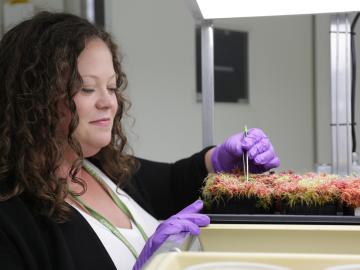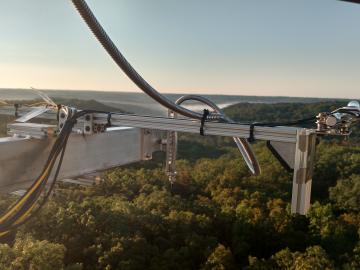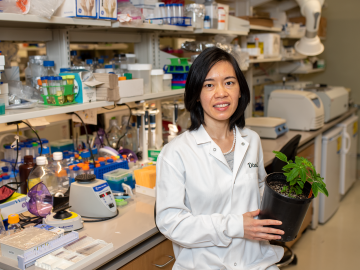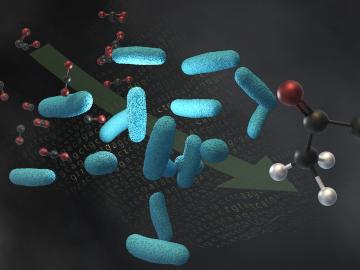
Filter News
Area of Research
- (-) Biology and Environment (83)
- Advanced Manufacturing (5)
- Biology and Soft Matter (1)
- Building Technologies (2)
- Computational Biology (1)
- Computational Engineering (2)
- Computer Science (4)
- Electricity and Smart Grid (1)
- Energy Science (144)
- Energy Sciences (2)
- Functional Materials for Energy (2)
- Fusion and Fission (10)
- Fusion Energy (1)
- Isotope Development and Production (1)
- Isotopes (28)
- Materials (59)
- Materials for Computing (9)
- Mathematics (1)
- National Security (19)
- Neutron Science (19)
- Nuclear Science and Technology (9)
- Quantum information Science (1)
- Sensors and Controls (1)
- Supercomputing (93)
News Topics
- (-) Energy Storage (7)
- (-) Frontier (3)
- (-) Isotopes (2)
- (-) Mathematics (4)
- (-) Mercury (7)
- (-) Security (2)
- (-) Summit (10)
- 3-D Printing/Advanced Manufacturing (11)
- Advanced Reactors (1)
- Artificial Intelligence (9)
- Big Data (10)
- Bioenergy (46)
- Biology (74)
- Biomedical (16)
- Biotechnology (14)
- Buildings (2)
- Chemical Sciences (12)
- Clean Water (11)
- Composites (5)
- Computer Science (19)
- Coronavirus (13)
- Critical Materials (1)
- Cybersecurity (1)
- Environment (91)
- Exascale Computing (4)
- Fusion (1)
- Grid (3)
- High-Performance Computing (20)
- Hydropower (8)
- Machine Learning (9)
- Materials (12)
- Materials Science (6)
- Microscopy (10)
- Molten Salt (1)
- Nanotechnology (7)
- National Security (3)
- Neutron Science (4)
- Nuclear Energy (1)
- Partnerships (6)
- Physics (2)
- Polymers (2)
- Simulation (15)
- Transportation (3)
Media Contacts

As the United States moves toward more sustainable and renewable sources of energy, hydropower is expected to play a pivotal role in integrating more intermittent renewables like wind and solar to the electricity grid

Microorganisms may provide hope that peatlands can withstand hotter temperatures in a changing climate.

Scientists develop environmental justice lens to identify neighborhoods vulnerable to climate change
A new capability to identify urban neighborhoods, down to the block and building level, that are most vulnerable to climate change could help ensure that mitigation and resilience programs reach the people who need them the most.

Technology developed at ORNL to monitor plant productivity and health at wide scales has been licensed to Logan, Utah-based instrumentation firm Campbell Scientific Inc.

ORNL scientists will present new technologies available for licensing during the annual Technology Innovation Showcase. The event is 9 a.m. to 3 p.m. Thursday, June 16, at the Manufacturing Demonstration Facility at ORNL’s Hardin Valley campus.

The rapid pace of global climate change has added urgency to developing technologies that reduce the carbon footprint of transportation technologies, especially in sectors that are difficult to electrify.

A team of researchers working within the Center for Bioenergy Innovation at ORNL has discovered a pathway to encourage a type of lignin formation in plants that could make the processing of crops grown for products such as sustainable jet fuels easier and less costly.

Surrounded by the mountains of landlocked Tennessee, Oak Ridge National Laboratory’s Teri O’Meara is focused on understanding the future of the vitally important ecosystems lining the nation’s coasts.

A team of scientists from LanzaTech, Northwestern University and ORNL have developed carbon capture technology that harnesses emissions from industrial processes to produce acetone and isopropanol

ORNL, TVA and TNECD were recognized by the Federal Laboratory Consortium for their impactful partnership that resulted in a record $2.3 billion investment by Ultium Cells, a General Motors and LG Energy Solution joint venture, to build a battery cell manufacturing plant in Spring Hill, Tennessee.


